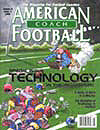Article CategoriesAFM Magazine
|
Glossary© More from this issueAmerican Football Monthly (a-mer- -kan fut-bol koch), noun 1. the only trade journal designed exclusively for the football professional. 2. the one-stop place for all football coaches to go to obtain up-to-the-minute information on everything from xs & os to sports nutrition that will help their program. 3. the magazine found on the desk of every successful coach in the nation.
Analog- a process whereby the recorded video image information is a continuous equivalent of the original scene. Spatial, brightness and color information are represented by signals that can have any value within the dynamic range of the recording process. Antivirus software- a computer program that provides protection from VIRUSES by making checks of the integrity of the operating system. No antivirus software can offer total ....The full article can only be seen by subscribers.
|
|
|||||||
| HOME |
MAGAZINE |
SUBSCRIBE | ONLINE COLUMNISTS | COACHING VIDEOS |
Copyright 2026, AmericanFootballMonthly.com
All Rights Reserved





